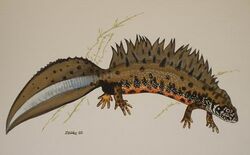Biology:Balanced lethal systems

In evolutionary biology, a balanced lethal system is a situation where recessive lethal alleles are present on two homologous chromosomes.[1] Each of the chromosomes in such a pair carries a different lethal allele, which is compensated for by the functioning allele on the other chromosome.[1] Since both these lethal alleles end up in the gametes in the same frequency as the functioning alleles, half of the offspring, the homozygotes, receive two copies of a lethal allele and therefore die during development.[1] In such systems, only the heterozygotes survive.[1]
Balanced lethal systems appear to pose a challenge to evolutionary theory, since a system so wasteful should be rapidly eliminated through natural selection and recombination.[2] Instead, it has become fixed in various species all over the tree of life.[1][2]
Mechanism
The exact mechanism behind balanced lethal systems remains unknown. Prior to the availability of efficient DNA sequencing methods, it was already known that the lethality in such a system was caused by homozygosity of a certain chromosome pair.[3][4]
One theory is that, in the case of the Triturus genus, the balanced lethal system is a remnant of an ancient sex-determination system.[1][2] One of the chromosomes of the pair that contains the system is longer than the other, which is also the case for the actual sex chromosomes.[2] In this theory, deleterious mutations accumulated on the non-recombining part of the Y-chromosome (Muller’s ratchet).[1][2][5] Then, two distinct Y-chromosomes, both with different lethal mutations, co-segregated in a population.[1] Since sex-determination in many cold-blooded vertebrates is potentially dependent on temperature, a shift away from chromosomal sex determination occurred.[1][2] This system favoured the sex reversal of females, which eventually led to the loss of the original X-chromosome.[1][2] A mutation on another chromosome later restored the even sex ratio, and gave rise to a new male-heterogametic system.[1][2] A major restriction for this theory is that it could only evolve in species where temperature-dependent sex-reversal is possible.[1] Since balanced lethal systems are found in many species where this is not the case, this theory does not provide a general explanation for how such a system evolved.[1]
Another theory is that balanced lethal systems are collapsed supergenes.[1] Supergenes are linked genes that are inherited as a single unit.[6] Genes can only be inherited together when recombination is suppressed, for example when selection favors certain allelic combinations.[6] The lack of recombination can lead to the accumulation of mutations in both supergene clusters[1][6] and this could generate a feedback loop:[1] when natural selection favours heterozygotes, few homozygotes reproduce.[1] This lack of reproduction leads to the accumulation of deleterious alleles. When lethal mutations become fixed on both supergene alleles, homozygotes are no longer viable, resulting in a balanced lethal system.[1]
Prevalence
A well known balanced lethal system is the one fixed in the genus Triturus (containing the crested and the marbled newts).[4] Each of the homologous chromosomes of pair 1 (1A and 1B) has a different recessive deleterious allele on a non-recombining section of the chromosome.[2] Therefore, only heterozygotes are viable since these deleterious alleles are compensated for by the functioning allele on the other homologue. As a result half of all offspring stop growing and die during early development.[2]
The offspring of Triturus carnifex for example, have either a viable heterozygous genotype (1A/1B) or one of the homozygous embryonic lethal genotypes: fat-tailed (1A/1A) or slim-tailed (1B/1B).[7]
See also
- Balancer chromosome
- Recessive lethals
- Northern crested newt
- Hermann Joseph Muller
- Linkage disequilibrium
References
- ↑ 1.00 1.01 1.02 1.03 1.04 1.05 1.06 1.07 1.08 1.09 1.10 1.11 1.12 1.13 1.14 1.15 1.16 1.17 "Balanced lethal systems". Current Biology 30 (13): R742–R743. July 2020. doi:10.1016/j.cub.2020.05.011. PMID 32634409.
- ↑ 2.0 2.1 2.2 2.3 2.4 2.5 2.6 2.7 2.8 2.9 "The balanced lethal system of crested newts: a ghost of sex chromosomes past?". The American Naturalist 180 (6): E174-83. December 2012. doi:10.1086/668076. PMID 23149410. https://www.journals.uchicago.edu/doi/10.1086/668076.
- ↑ "Lampbrush chromosomes of crested newts Triturus cristatus (Laurenti)" (in en). Philosophical Transactions of the Royal Society of London. Series B, Biological Sciences 243 (702): 135–219. 1960-11-24. doi:10.1098/rstb.1960.0007. Bibcode: 1960RSPTB.243..135C.
- ↑ 4.0 4.1 "Heteromorphism for chromosome 1, a requirement for normal development in crested newts" (in en). Chromosoma 76 (2): 111–122. January 1980. doi:10.1007/BF00293412.
- ↑ "Deleterious mutation accumulation and the long-term fate of chromosomal inversions". PLOS Genetics 17 (3): e1009411. March 2021. doi:10.1371/journal.pgen.1009411. PMID 33661924.
- ↑ 6.0 6.1 6.2 "Quick Guide Supergenes". Current Biology 29 (13): R603–R622. July 2019. doi:10.1016/j.cub.2019.05.024. PMID 31287973. https://www.cell.com/current-biology/pdf/S0960-9822(19)30559-7.pdf.
- ↑ "The balanced lethal system of crested newts" (in en). Heredity 73 (1): 41–46. July 1994. doi:10.1038/hdy.1994.96.
Further reading
- "Lethal mutations and balanced lethal systems in Aspergillus nidulans". Journal of General Microbiology 49 (1): 149–55. October 1967. doi:10.1099/00221287-49-1-149. PMID 6064441.
- "Supergenes and complex phenotypes". Current Biology 24 (7): R288–94. March 2014. doi:10.1016/j.cub.2014.01.056. PMID 24698381.
- "Genetic Variability, Twin Hybrids and Constant Hybrids, in a Case of Balanced Lethal Factors". Genetics 3 (5): 422–99. September 1918. doi:10.1093/genetics/3.5.422. PMID 17245914.
- "Asd-based balanced-lethal system in attenuated Edwardsiella tarda to express a heterologous antigen for a multivalent bacterial vaccine". Fish & Shellfish Immunology 34 (5): 1188–94. May 2013. doi:10.1016/j.fsi.2013.01.027. PMID 23454428.
- A balanced lethal system in the flour beetle, Tribolium castaneum. Heredity.. 22. August 1967. pp. 435–8. doi:10.1038/hdy.1967.52.
 |

